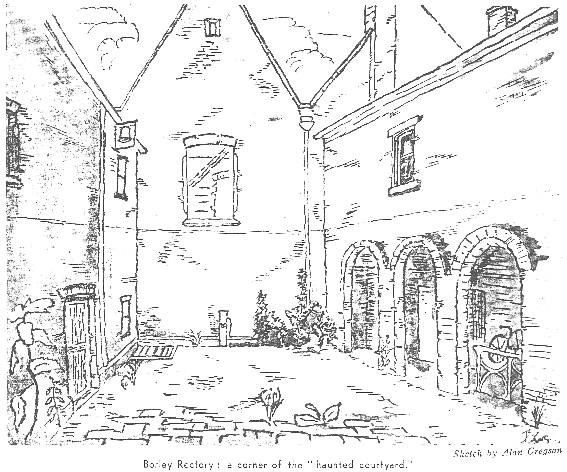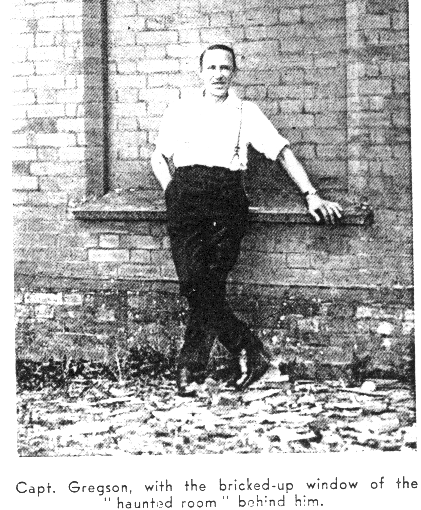

I bought the Rectory (which I then re-named Priory, in commemoration of its traditional origin) in full knowledge of its Ghostly reputation, and in complete skepticism.
I have since found ample cause to admit that there are influences exisiting, and active, in and around the place, which are outside the limits of what we are accustomed to consider the normal.
During the past fifty years, the Rectory has steadily been earning for itself a high place in the ranks of "Haunted Houses," and when, recently, a correspondent in Los Angeles (California) addressed a letter to me: "The Most Haunted House in England," it was duly and promptly delivered to me at Borley Rectory, which suggests, at any rate, that no more notably haunted house is known to the G.P.O.
The Rectory is not an ancient building. Its age is sixty or seventy years only, but it occupies the site of age-old foundations, and the under-structure and vaults are closely linked with the far past, inasmuch as here once stood a Priory (of the Cistercian Order, so far as I can ascertain.)
It is on record that on the Dissolution of Monasteries, the Vessels and huge treasure then held by the Priory were not confiscated, nor accounted for, and this was because they had been too skillfully concealed about the precincts by the Prior and his Monks.
Spasmodically, during the intervening years, searches have been made. Recently, the most noted Metal Diviners have tired their skill, but the treasure still remains hidden where the old Cistercians placed it.
The Ghosts who haunt the place carry one's thoughts back forcibly to the Middle Ages. A Novice, of the Nunnery of Bures, and a young Monk of Borley Priory fell in love. One can visualise their untold schemings for secret meetings (rare and sweet moments). . . . the brooding suspicion aroused, the traps laid, and finally, the surprise and capture of the lovers as they were escaping together in a coach.
The Monk was put to death, and the Nun was doomed to be walled-up alive in the valuts below the Priory, and the cruel sentence was carried out.
But neither his Spirit, nor hers, has ever rested. Who can say whether it is that they feel that, for their sins, they dare not aspire to a better state but must remain tied forever to haunt the scene?
The Nun has been seen, not once, but scores of times, and by scores of people, people whose evidence cannot be doubted, because they have been persons of all ages, of all stations, of all degrees of education, and of all types (more especially of a definitely non-sympathetic and non-psychic class).
It is recorded that, a generation ago, the Nun's appearance in the children's Nursery on dark winter's evenings was so frequent an event that the children of that day used to look for her, and to welcome her appearance.
It may be supposed that her troubled Spirit found moments of rest and peace during those short visitations. Let us hope so, because, excepting for this happy touch, all that has been seen of the Nun has emphasised her restlessness and anguish.

She used to gaze through a window in the gloomy dining room. Cheery, hospitable parties around the dining-table may have jarred upon her poor, agony-strained feelings. Suddenly, a strange chill would creep through the room. . . . a sudden silence fall, and one or other of those jovial diners would glance toward the window, would see there the pale, sad face, coiffed in grey.
Those manifestations became so frequent that it was decided to end them by bricking up the window, and this was done. (The window, bricked up, can be seen on the left-hand side of the front-door porch.)
Sometimes, the Nun has been seen wandering the grounds. Thirty years ago, a local young man,
(now a burly woodcutter, from whose lips I lately heard the incident) with another youth, was in
the shrubbery near the Moat at dusk. In his own words:
"Why we was there, don't matter, but there we was. And we saw a lady all muffled up in grey
come out from the bushes and go towards the moat. We wondered who she could be, and why
she were there all amongst the wet bushes. She went quiet-like, and when she came to the edge
of the water she wasn't there.
"My mate and I rushed out from where we was hiding, and I called to him, 'Quick, Charlie, she's
fallen in the water.' But when we got to the edge, there was nothing."
Then, Monk and Nun together have passed occasionally through the trees or across the lawn, and they have been so seen (and by many witnesses) as lately as February of the present year.
The disastrous fire at the Rectory may have had some disturbing influence because, during the night of the fire, several people report having seen me, accompanied by two "Strangers," one, a "Lady, dressed in a grey cloak," the other, "A gentleman with a sort of bald head, dressed in a long black gown."
This testimony is particularly interesting, because as it came, first from total strangers, who had never heard of the legend, nor of the ghostly reputation of the Rectory.
And there are other restless Spirits dwelling around the place. If one Ghost, or two, are to be admitted, why should others (kindred in restlessness and despair) of any degree of benevolence, mere mischief, or utter malevolence, not associate themselves in congenial surroundings?
So, at Borley Priory, there have been numberless occurrences of "Poltergeist," the violent moving of heavy furniture, the flinging of bottles and stones, the ransacking of locked cupboards, the ringing of bells. Footsteps, at times, are heard in the empty passages. A sad wailing voce rises from the cellar-well (the treacherous well over which I fastened a heavy cover, only to find that cover flung off, the next day, and lying at the further side of the cellar).
Already, the fate of my two spaniels has been published and broadcast far and wide. How, first, wise old "Peter" (a five-year-old black Cocker) and afterwards "Joe" (six-month-old Cocker) showed their dread of the gloomy Courtyard; how, even during daylight, they could scarcely be persuaded to enter it, and how each in turn went mad with terror at something which they sensed beyond the threshold of the Courtyard, and died mad.
To end - I can only repeat that I am not superstitious, that I have neither belief (nor much interest) in "Ghosts." But I am obliged to believe the evidence of my own eyes and ears, and I should be foolish indeed to condemn the evidence of the hundred or more living witnesses who bear circumstantial evidence to the strange happenings such as those to which I have referred.
A definitely abstruse problem is presented here. What is the explanation? To conclude with my concluding words at my recent broadcast: "Who knows?"